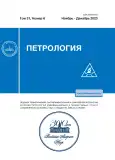The Effects of Alkalis Content on Zircon Solubility in Silicate Melts
- Authors: Borisov A.A.1, Koshlyakova A.N.1,2
-
Affiliations:
- Institute of Geology of Ore Deposits, Petrography, Mineralogy, and Geochemistry, Russian Academy of Sciences
- Vernadsky Institute of Geochemistry and Analytical Chemistry Russian Academy of Sciences
- Issue: Vol 31, No 6 (2023)
- Pages: 677-684
- Section: Articles
- URL: https://journals.rcsi.science/0869-5903/article/view/232184
- DOI: https://doi.org/10.31857/S0869590323060055
- EDN: https://elibrary.ru/EFWFIU
- ID: 232184
Cite item
Full Text
Abstract
The experimental study of the effects of alkalis content on zircon solubility in multicomponent model silicate melts was conducted in temperature range 1300–1400°С and at 1 atm total pressure. It was demonstrated that the addition to the melt of Na2O and K2O results in comparable increase of zircon solubility. The advantages and disadvantages of the parameters describing zircon solubility are shortly discussed.
Keywords
About the authors
A. A. Borisov
Institute of Geology of Ore Deposits, Petrography, Mineralogy, and Geochemistry,Russian Academy of Sciences
Author for correspondence.
Email: aborisov@igem.ru
Russia, Moscow
A. N. Koshlyakova
Institute of Geology of Ore Deposits, Petrography, Mineralogy, and Geochemistry,Russian Academy of Sciences; Vernadsky Institute of Geochemistry and Analytical Chemistry Russian Academy of Sciences
Email: aborisov@igem.ru
Russia, Moscow; Russia, Moscow
References
- Борисов А.А. Экспериментальное исследование распределения K и Na между смешивающимися жидкостями // Петрология. 2008. Т. 16. № 6. С. 593–605.
- Борисов А.А. Зависимость коэффициентов активности щелочей от кремнекислотности и глиноземистости расплавов: экспериментальное исследование // Петрология. 2009. Т. 17. № 6. С. 623–635.
- Boehnke P., Watson E.B., Trail D. et al. Zircon saturation re-revisited // Chem. Geol. 2013. V. 351. P. 324–334.
- Borisov A., Aranovich L. Zircon solubility in silicate melts: new experiments and probability of zircon crystallization in deeply evolved basic melts // Chem. Geol. 2019. V. 510. P. 103–112.
- Borisov A., Lahaye Y., Palme H. The effect of sodium on the solubilities of metals in silicate melts // Amer. Mineral. 2006. V. 91. P. 762–771.
- Borisov A., Pack A., Kropf A., Palme H. Partitioning of Na between olivine and melt: an experimental study with application to the formation of meteoritic Na2O-rich chondrule glass and refractory forsterite grains // Geochim. Cosmochim. Acta. 2008. V. 72. P. 5558–5573.
- Borisov A., Behrens H., Holtz F. Effects of strong network modifiers on Fe3+/Fe2+ in silicate melts: an experimental study // Contrib. Mineral. Petrol. 2017. V. 172. Article 34.
- Borisov A., Behrens H., Holtz F. Ferric/ferrous ratio in silicate melts: a new model for 1 atm data with special emphasis on the effects of melt composition // Contrib. Mineral. Petrol. 2018. V. 173. Article 98.
- Crisp L.J., Berry A.J. A new model for zircon saturation in silicate melts // Contrib. Mineral. Petrol. 2022. V. 177. Article 71.
- Corrigan G., Gibb F.G.F. The loss of Fe and Na from a basaltic melt during experiments using the wire-loop method // Mineral. Mag. 1979. V. 43. P. 121–126.
- Gervasoni F., Klemme S., Rocha-Júnior E.R.V., Berndt J. Zircon saturation in silicate melts: a new and improved model for aluminous and alkaline melts // Contrib. Mineral. Petrol. 2016. V. 171. Article 21.
- Koshlyakova A., Sobolev A., Krasheninnikov S. et al. Ni partitioning between olivine and highly alkaline melts: an experimental study // Chem. Geol. 2022. V. 587. Article 120615.
- Mills K.C. The influence of structure on the physico-chemical properties of slags // ISIJ International. 1993. V. 33. P. 148–155.
- Watson E.B., Harrison T.M. Zircon saturation revisited: temperature and composition effects in a variety of crustal magma types // Earth Planet. Sci. Lett. 1983. V. 64. P. 295–304.
- Watson E.B. Zircon saturation in felsic liquids: experimental results and applications to trace element geochemistry // Contrib. Mineral. Petrol. 1979. V. 70. P. 407–419.
Supplementary files













